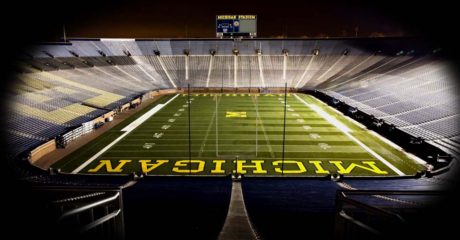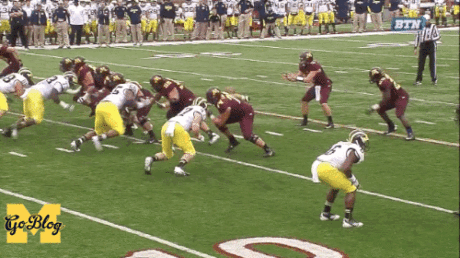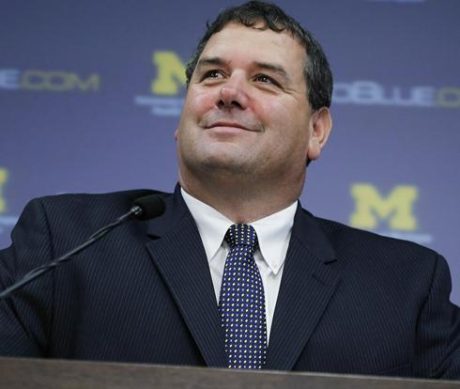I posted the offense yesterday (LINK), so here are the defenders and specialists. Since Michigan ran a 4-3 Under for three of Hoke’s four years, I’m going with that look for my all-star team.
SDE: Ryan Van Bergen (2011)
45 tackles, 12.5 tackles for loss, 5.5 sacks, 1 forced fumble, 3 fumble recoveries, 4 pass breakups
Van Bergen was a stalwart defensive end for Michigan as a senior, earning All-Big Ten Honorable Mention but helping the entire defense by getting consistent penetration and having a great game in the win against Ohio State.
NT: Ryan Glasgow (2014)
24 tackles, 4 tackles for loss, 1 forced fumble, 1 fumble recovery
Glasgow made huge strides from his redshirt freshman to redshirt sophomore season, which propelled him past Quinton Washington for this spot. Glasgow was mostly able to hold his ground against double teams.
DT: Mike Martin (2011)
64 tackles, 6 tackles for loss, 3.5 sacks
Martin was named Second Team All-Big Ten for his performance in 2011, and he was consistently in the opponent’s backfield. Opposing centers couldn’t handle him one-on-one as a nose tackle, which allowed some young and/or mediocre linebackers behind him to make plays.
WDE: Frank Clark (2014)
42 tackles, 13.5 tackles for loss, 4.5 sacks, 1 fumble recovery, 2 pass breakups
I hesitated to put Clark on here because he was kicked off the team for an (alleged) domestic violence transgression. But just looking at the on-field results, Clark was a force. He achieved the above numbers in just ten games before being booted, and they would have been higher if Michigan’s coverage in the secondary hadn’t been so poor in the early part of the season.
Hit the jump for linebackers, defensive backs, and specialists.
SLB: Jake Ryan (2012)
88 tackles, 16 tackles for loss, 4.5 sacks, 4 forced fumbles, 1 fumble recovery, 3 pass breakups
Ryan was a huge playmaker for the Wolverines coming off the edge, and he had an ability to keep faster players from breaking contain. He was a capable pass rusher who sometimes played defensive end or blitzed from the interior of the defense.
MLB: Desmond Morgan (2012)
81 tackles, 5.5 tackles for loss, .5 sacks, 2 pass breakups
Pick any year from 2011 to 2013, and Morgan was basically the same guy in each. Other than a superb one-handed interception against UConn in 2013, I thought he peaked as a sophomore (he has one year remaining after redshirting this past season). Just a steady presence in the middle of the field.
WLB: Joe Bolden (2014)
102 tackles, 4 tackles for loss, 2 sacks, 1 pass breakup
This was a tough choice between Bolden and Kenny Demens, but I think Bolden has developed into a better tackler than Demens. Bolden looked a little out of place in his first two years, but he emerged as a junior under the tutelage of defensive coordinator Greg Mattison, who took over the linebacker position.
CB: Blake Countess (2013)
46 tackles, 2 tackles for loss, 6 interceptions (1 touchdown), and 4 pass breakups
Playing a lot of nickel corner in 2013, Countess was outstanding. He was named First Team All-Big Ten and tied for the conference lead in interceptions.
CB: Jourdan Lewis (2014)
39 tackles, 1.5 tackles for loss, 2 interceptions, 6 pass breakups
Lewis got called for a few pass interference penalties, but he almost never got cleanly beaten by defenders. He was the only defensive back to record an interception in 2014, and his hustle plays against Utah and Maryland saved a couple potential touchdowns.
S: Thomas Gordon (2011)
67 tackles, 1.5 tackles for loss, 1 interception, 2 forced fumbles, 4 fumble recoveries, 2 pass breakups
Surely it was a run of good luck, but Gordon was always around the ball as a redshirt sophomore in 2011. From his one-handed interception against Eastern Michigan to his four recoveries, he was a takeaway machine.
S: Jordan Kovacs (2011)
75 tackles, 8 tackles for loss, 4 sacks, 1 interception, 2 forced fumbles, 1 fumble recovery, 1 pass breakup
Kovacs was a revelation for Michigan fans who were used to predictable defense from 2008-2010. Often used as a blitzer, Kovacs would stunt off the edge and was very adept at keeping outside contain despite average speed.
PR: Jeremy Gallon (2011)
19 returns, 192 yards, 10.1 yards/return
In general, the returners were not good during Hoke’s tenure. Gallon was the only one able to manage over 10 yards/return, nobody returned a punt for a touchdown (blocked punts notwithstanding), and Hoke generally went for safety over big-play ability.
KR: Dennis Norfleet (2013)
40 kickoff returns, 938 yards, 23.5 yards/return
Norfleet is #1 all-time at Michigan in career returns (94) and return yardage (2,203). I thought his patience and vision were best in 2013, but all three seasons have seen him with between a 23.05 and 23.63 yard average with a long return of 38-44 yards, so his seasons are mostly indistinguishable from each other.
P: Will Hagerup (2012)
45.0 yards/punt, 3 inside the 20-yard line, 4 touchbacks, 4 fair catches, 13 punts of 50+ yards
It’s tough to pick a season for Hagerup. He was the Big Ten Punter of the Year in 2012, but the coaches in the conference voted him as Honorable Mention All-Big Ten. He showed a big leg, but he only pinned teams inside their own 20-yard line 3 times while having 4 touchbacks (by contrast, he landed 16 inside the 20-yard line in 2014 but also had 9 touchbacks while averaging 42.9 yards/attempt).
K: Brendan Gibbons (2012)
16/18 on field goals (88.9%) with a long of 52, 45/45 on extra points
Gibbons had some memorable kicks in each of his final three years, but he was clutch in 2012. He hit his career long of 52 against Nebraska, he knocked one through to send the Northwestern game to overtime, and he hit the game-winner against Michigan State.
LS: Jareth Glanda (2011)
1 catch for 11 yards
Glanda was only the short snapper (field goals, extra points) in 2011, leaving the long snapping duties (punts) to Tom Pomarico. But Pomarico never caught a pass like Glanda did in the Sugar Bowl. Neither one had a bad snap, and Glanda would go on to be the long snapper in 2012 and 2013, but I’m picking 2011 because it’s my blog, dammit.
H: Drew Dileo (2011 and 2013)
Once again, I’m breaking the rules because you can’t stop me. In 2011 Dileo converted three fake field goals – a 3-yard run against Michigan State, a 4-yard run against Nebraska, and a pass (which was tipped and ended up in the hands of Glanda). Then again, in 2013 he slid into the holding position for Brendan Gibbons’s game-tying field goal at the end of regulation, which helped turn a loss into an eventual victory.







